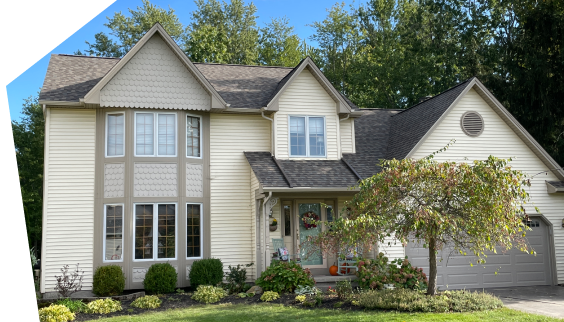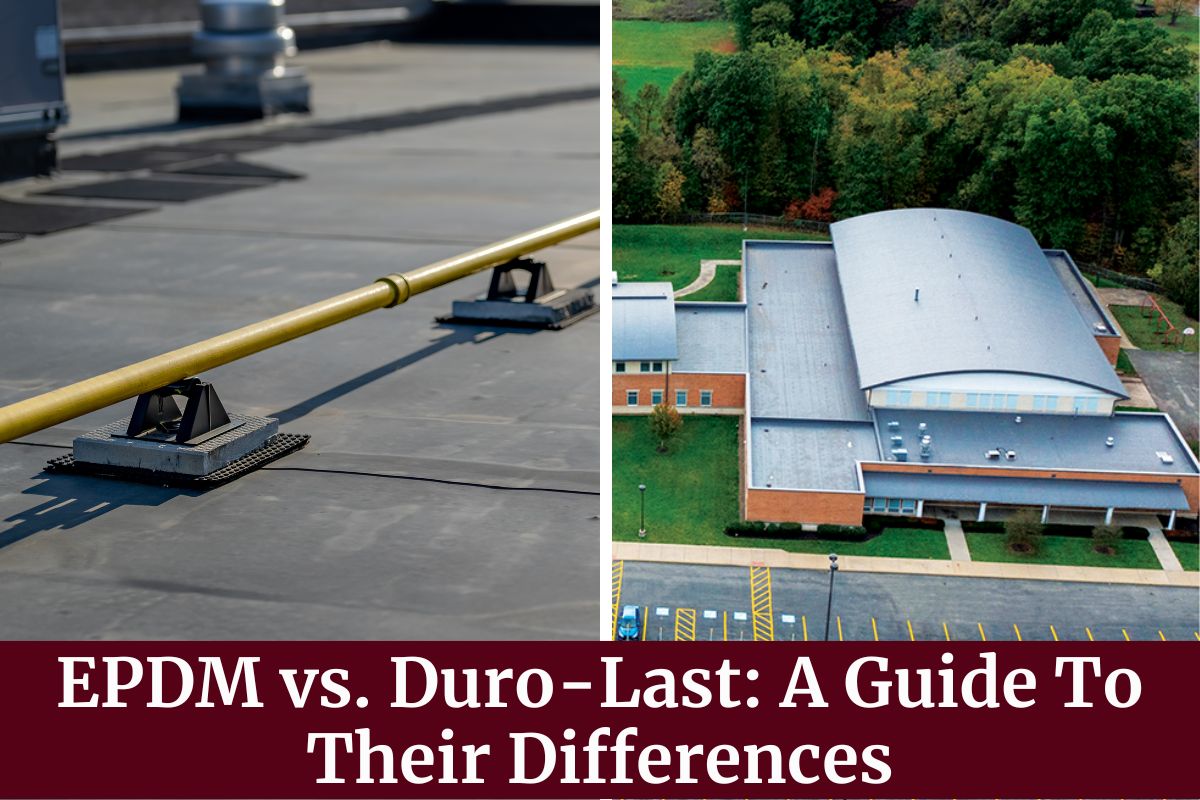There are numerous options available when choosing a roofing system for commercial buildings. Duro-Last and EPDM (ethylene propylene diene monomer) are two common options. However, the best option for your building will depend on a number of factors, as each has particular benefits and drawbacks.
In this blog post, we will do a thorough comparison of EPDM and Duro-Last roofing systems, providing information on their features, benefits, and main distinctions.
What Is EPDM?

EPDM is a synthetic rubber roofing membrane used globally on low-slope buildings. It is made from ethylene and propylene sourced from oil and natural gas. EPDM comes in black and white variants, various widths, and two thickness options: 45 and 60 mils.
Installation methods include fully adhered, mechanically attached, or ballasted, with seams sealed using liquid adhesives or specialized tape. Renowned for their durability and energy efficiency, EPDM roofs withstand UV rays, extreme temperatures, and severe weather conditions while being water-resistant.
They require minimal maintenance and are cost-effective compared to alternative roofing materials. While commonly utilized for commercial roofs, EPDM also has applications in residential settings.
What Is Duro-Last?

Another kind of commercial roofing system intended for flat or low-sloping roofs is Duro-Last. It is a type of PVC membrane that offers resistance to fire, chemicals, high winds, grease, and punctures. Roofs built with Duro-Last are renowned for their strength, longevity, and energy efficiency. Up to 85% of the seams are finished in a factory setting, guaranteeing greater integrity and a lower risk of leaks.
These roofs offer an accurate and durable solution since they are made to match the precise measurements of every building. Commercial buildings frequently choose Duro-Last membranes because they are highly customizable, long-lasting, eco-friendly, and backed by industry-leading warranties.
A Comparison: Duro-Last vs. EPDM
1. Installation Process and Complexity
The complexity of an EPDM roof installation depends on the installation method. Fully adhered systems employ fasteners to secure the EPDM membrane to the roof deck, whereas mechanically attached systems use adhesive. Ballasted systems use gravel or other materials to cover the membrane in order to provide protection and weigh the material down.
The seams on Duro-Last roofs are heat-welded for a seamless, waterproof finish, and the roofs are prefabricated in a controlled factory environment. This process ensures a higher degree of precision and accuracy, making the roofing system more dependable and long-lasting.
2. Maintenance Needs and Repairs
The only maintenance needed for EPDM roofs is the occasional seam re-adhesion or patching job to fix any leaks or damage. EPDM roofs, however, might be more vulnerable to harm from debris, foot traffic, and other sources.
Regular inspections are necessary to guarantee the integrity of heat-welded seams on Duro-Last roofs. Even though Duro-Last roofs are extremely resilient and long-lasting, routine inspections can help spot possible problems early on and fix them before they become serious ones.
3. Cost and Durability
Building owners with a small budget may find EPDM roofing systems to be a more appealing alternative to Duro-Last systems due to their lower installation costs. But depending on installation quality and maintenance, EPDM roofs typically last 15 to 25 years less than Duro-Last roofs. Over time, the total cost may increase if EPDM roofs need more frequent repairs and maintenance.
Even though they cost more to install, Duro-Last roofing systems can last up to 30 years or longer, depending on how well they are maintained. A Duro-Last roof may be a more cost-effective long-term investment, even though the initial installation cost may be higher.
4. Material and Manufacturing
EPDM is a synthetic rubber material resilient to weathering, UV rays, and temperature changes, along with being highly flexible.
A unique combination of PVC resins, stabilizers, and other ingredients is used to make Duro-Last. Weathering, UV rays, chemicals, and fire pose little threat to this material.
5. Weather Resistance and Energy Efficiency
Generally speaking, EPDM roofs are less energy-efficient than Duro-Last roofs because of their black color, which absorbs heat, potentially increasing summertime cooling expenses. However, to increase their energy efficiency, EPDM roofs can be covered with a reflective roof coating.
Since Duro-Last roofs are naturally more reflective, they can help lower cooling expenses. These roofs are also more resilient to temperature changes, UV rays, and weathering, which makes them a great option for buildings situated in regions with harsh weather.
6. Warranties and Customer Support
Warranties and customer support vary by manufacturer, with some EPDM manufacturers offering warranties ranging from 10 to 20 years. Duro-Last is known for its lifetime warranties and customer support, which provide building owners with peace of mind and protection against potential issues.
EPDM vs. Duro-Last: Pros And Cons
Here’s a simplified breakdown of all the components we’ve addressed:
EPDM
Pros:
- Cost-effective: Affordable at around $0.80/square foot.
- Versatile: Can be installed using adhesive, fasteners, or a ballasted system, adaptable to various roof configurations.
- Lightweight: This does not require additional roof deck reinforcement due to its lightweight nature.
- Durable: Lasts 20+ years, resistant to UV radiation, ozone, and extreme temperatures.
Cons:
- Less puncture-resistant: Vulnerable to punctures from falling debris or foot traffic.
- Shorter lifespan: It does not last as long as some other materials like PVC.
- Prone to damage: More susceptible to damage from debris or foot traffic, potentially leading to leaks.
Duro-Last
Pros:
- Durable: Resistant to punctures, tears, and impacts.
- Pre-fabricated: Stronger seams and precise fit due to off-site prefabrication.
- Energy-efficient: Highly reflective, reducing energy costs and improving building comfort.
- Lifetime Warranty: Usually covered under a lifetime warranty, providing peace of mind for building owners.
Cons:
- Higher cost: Generally more expensive than EPDM and TPO.
- Longer installation time: Requires more time for installation, leading to higher labor costs and disruption.
Choosing the Right Roofing System for Your Commercial Building
There are a few determining factors that can help you effectively choose the right roofing system for your commercial building
1. Budget:
Consider both upfront costs and long-term expenses, including maintenance and repairs. Choose a roofing system that fits your budget while offering durability and performance.
2. Building Design:
Assess factors like roof slope, size, and complexity. Select a roofing solution that meets structural requirements and complements the building’s aesthetic and function.
3. Location:
Take into account local climate and weather conditions. Choose a roofing system that can withstand prevalent weather patterns and ensure compliance with local building codes and regulations to avoid issues. Consulting with a professional roofing contractor can provide valuable guidance tailored to your specific needs.
Final Verdict: Duro-Last vs. EPDM
The choice between Duro-Last and EPDM is based on personal preferences and needs. For many applications, EPDM is a good option because of its flexibility, resilience to weathering, and resistance to UV rays.
On the other hand, as mentioned previously in this blog post, Duro-Last has prefabricated sheets for seamless installation and outstanding resistance to weathering, UV radiation, chemicals, and fire. Although each has advantages, it’s important to weigh your building’s needs and preferences for installation, as well as other factors like climate and budget.
Get The Best Commercial Roof Installation In Buffalo, NY
When comparing EPDM and Duro-Last roofing systems, it’s essential to assess their unique advantages and suitability for your project. EPDM provides cost-effectiveness and installation flexibility, while Duro-Last offers durability and ease of installation. If you’re considering EPDM, turn to OConnor Contracting for reliable expertise and tailored EPDM solutions. With our commitment to quality and customer satisfaction, we ensure your roofing needs are met with precision and care. Reach out to OConnor Contracting today at (716) 600- 7663 to learn more about how we can help you.


